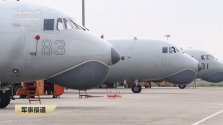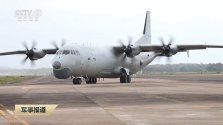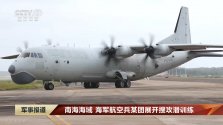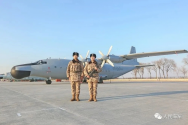You are using an out of date browser. It may not display this or other websites correctly.
You should upgrade or use an alternative browser.
You should upgrade or use an alternative browser.
PLA AEW&C, SIGINT, EW and MPA thread
- Thread starter Sczepan
- Start date
Those are Y-8s?Nice images of Y-8Q in low-visibility paint scheme.
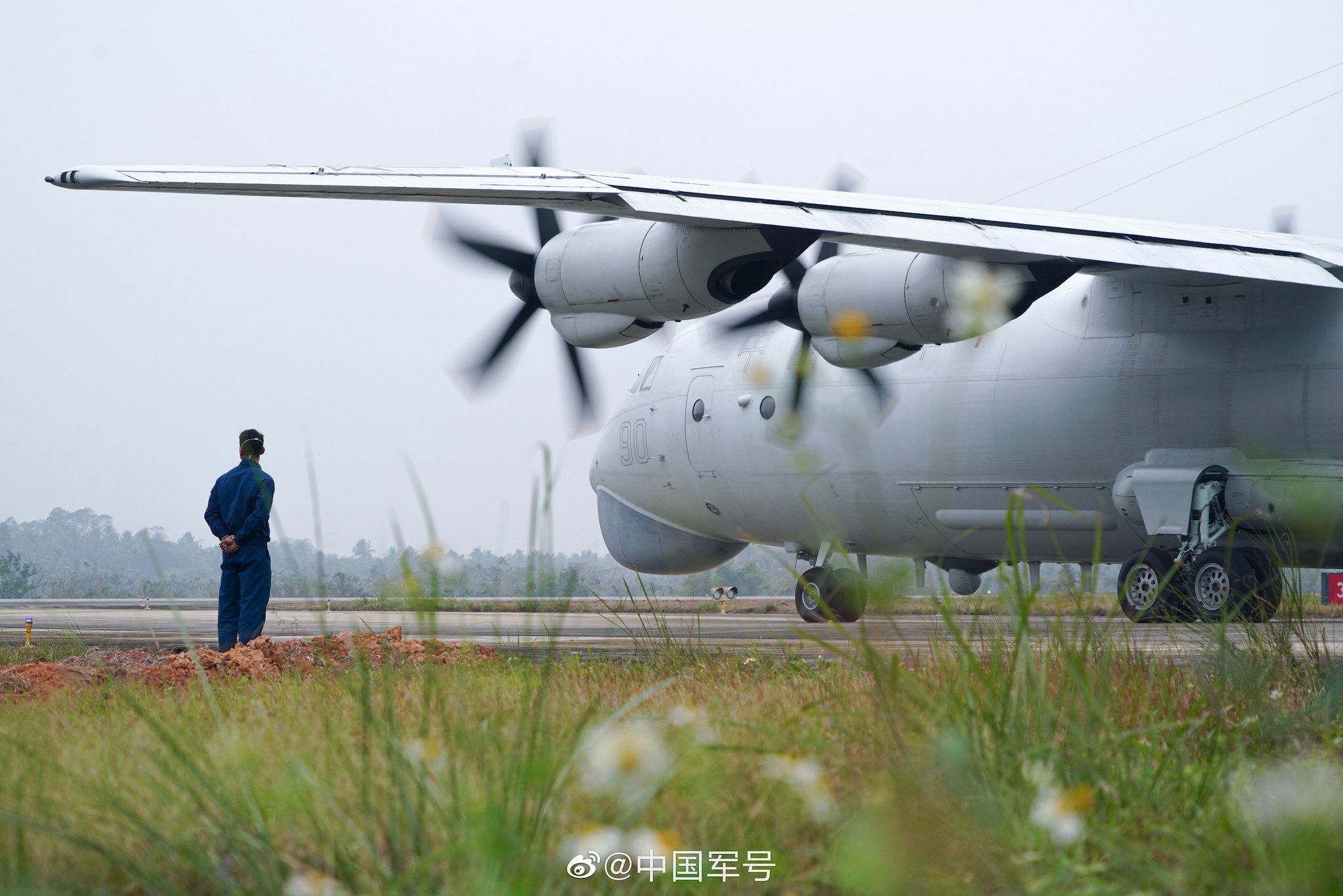



Last edited:
Those are Y-8s?
Yes and no ... officially they are called KQ-200 or Y-8G or Y-8GX-6 even if they are airframe, powerplant and avionics-wise more related to the Y-9.
lcloo
Major
Y-8J always remind me of Nimrod and its Skymaster radar.Now the old Y-8J AEW is also going low-visibility grey!
(Image via @沉默的山羊 from Weibo)
View attachment 105139
From wikipedia, regarding the Skymaster radar on Y-8J.
- Skymaster: Development of Searchwater AEW/LAST, combining the air-to-surface capability of the original Searchwater and the air-to-air capability of Searchwater AEW/LAST. Developed as the radar for Argus-2000 AEW&C system to be installed on . which was eventually cancelled. However, 6 complete Argus-2000 AEW&C systems plus two more Skymaster radar as spares were purchased by China in 1997 for 66 million US dollars. The experienced gained from Skymaster/Argus-2000 program despite its eventual cancellation has been used in the modernization of other models of Searchwater radars.
Now the old Y-8J AEW is also going low-visibility grey!
(Image via @沉默的山羊 from Weibo)
View attachment 105139
I sense a secret collaboration with Israeli's somewhere in the past. The funky nose cone (radome) must be inspired by Israel's EL/M-2075 Phalcon!
We have something like that with AEW UAV I think.
Aside from that, KJ-500 operates in the L band. If KJ-600 is anything like E-2D, it would be operating in the upper range of UHF band. All of which should have fairly long detection range against F-35.
You mean something like the JY-300?
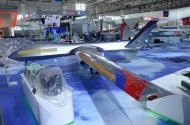
Apparently said model has taken flight as early as 2018.
Should be expected to enter serivce with the PLAAF and PLANAF soon?
You mean something like the JY-300?
View attachment 105567
Apparently said model has taken flight as early as 2018.
Should be expected to enter serivce with the PLAAF and PLANAF soon?
They already have been used in an exercise last year, with good results too.
Just came across this video on Bilibili posted early this month (only available in Mandarin):
The video discusses regarding general requirements for airborne early warning and control (AEW&C) aircrafts, plus the pros and cons of using civilian airliners versus airlifters as platform for AEW&C aircrafts. The video uses American E-3 Sentry (based on the Boeing 707 airframe) and Russian A-50 (based on the Ilyushin Il-76 airframe) as subjects of comparison. Besides, the video also relates the talking points onto whether China should choose XAC Y-20 or COMAC C919 as the more suitable platform for next-generation AEW&C aircraft.
The general consensus achieved by the narrator and viewers is that COMAC C919 is definitely the better choice, as the airframe offers greater fuel efficiency, longer cruising range, better crew comfort, lower noise levels, larger degree of modification and upgrade availabilities, etc compared to the XAC Y-20. However, if the next-generation AEW&C is needed by the PLAAF and PLANAF ASAP, no doubt XAC Y-20 will be picked, as the Y-20 is the only medium-sized transport platform available to China.
I'm thinking that PLAAF and PLANAF have been eagerly waiting for COMAC C919 to become maximally/fully domestic before they would base their next-generation AEW&C platforms upon. Another choice would be the COMAC C929 (Yes, I no longer sees CRAIC CR929 is a likely proposition into the future), but it could be another 10-15 years before the plane is ready for civilian use, let alone military application.
The video also discusses the generation of AEW&C aircrafts since its inception to today. To put it simply:
A) 1st-generation (1940s-1960s):
- Essentially just putting air-search radar into the sky
- Relay information of enemy airborne units to command posts on the ground
- Limited to no command and guidance capabilities for allied warplanes
- Examples: TBM-3W, E-1B, Tu-126
B) 2nd-generation (1970s-1990s):
- Improved radar sets (pulse-Doppler), early warning, enemy unit detection, identification and response capabilities
- Guidance of allied warplanes for strike missions and interception of enemy air units, with limited ELINT capability
- Airborne command-and-control role
- Examples: E-2C, E-3, A-50, KJ-2000, KJ-200
C) 3rd-generation (2000s-2020s?):
- Advanced radar sets (multi-phase AESA), data chain, limited cross-platform AEW distribution of functionality
- Collaborative detection and integration of multi-source information into unified situational map
- Core node of networked, diverse, unitifed combat system in the sky
- Examples: E-2D, E-7, E-10, G550 CAEW, A-100, KJ-500, KJ-600
So far, I could confidently say that China's AEW&C capabilities are among the frontrunners in the world, with the KJ-500 and upcoming carrier-based KJ-600 shouldering this responsibility across the PLAAF and PLANAF. In fact, China's current AEW&C units might be one of the major factors for the USAF in ordering that their E-3 fleet be replaced with the newer E-7s as soon as possible.
However, with the proliferation of high-performance stealth fighters, long-range AAMs and SAMs in the coming years can all pose a realistic threat to AEW&C aircrafts, the ability of AEW&C aircrafts to continue the iteratation and upgrade must keep growing. This is where the next-generation i.e. 4th-generation AEW&C aircrafts come in, as contemporary powers like the US and China are in active pursuit right now.
Here are the key capabilties where 4th-generation AEW&C aircrafts should have:
#1 - Reliable ability to detect stealthy targets.
- Development of stealthy warplanes and the use of longer-range missiles with LO capabilities correspondingly compress the detection range by AEW&C aircrafts, resulting in the reduction of the survival of AEW&C aircrafts on the battlefield.
-The next-generation AEW&C aircrafts must have the reliable ability to detect stealthy targets in order to survive on the future battlefield. (Which necessitate the development and deployment of even more advanced radar technologies and detection methods)
#2 -Substantial unmanned distributed early warning capability.
- AEW drones can massively assist in the AEW&C networks through integrated design, with advantages of lower airflow resistance, long flight time, load weight, etc.
- Future AEW&C aircrafts will realize the decentralization of early warning reconnaissance, command and guidance functions in order to achieve the "man in the loop" unmanned distributed early warning pattern.
- Increasing the number of and distance between early warning and reconnaissance units in the battle space distribution would improve the ability to resist strikes and battlefield survivability.
- Reducing cost and complexity of early-warning system, while expanding detection and interception limits.
#3 - The ability to co-integrate and link of the early warning system across the entire region and theater of war.
- Advanced Battle Management System (ABMS), i.e. New generation of battlefield surveillance, combat management, and command and control system.
- Providing more effective air, ground and surface target reconnaissance and identification functions by connecting various multi-source heterogeneous sensors in the battlefield, plus performing unified, centerless fusion of sensor data, with multi-domain combat management and control capabilities.
- Distributed, multi-domain interconnection and sharing features further enhance the system's survivability on the battlefield. (This is where we see future warplanes like the B-21's importance comes in)
- Open architecture design allows for rapid integration of new sensors and weapons platforms.
- Future AEW&C aircrafts would evolve into becoming information processing and resource allocation nodes in the system.
#4 - "Intelligent" command and control capabilities.
- Man-machine collaborative operations to become the new form of air warfare, while unmanned warfare to become the new mode of warfare.
- With the gradual and deep involvement of AI in modern warfare, future early warning machines will be done in the depth of human-machine interaction, the application of ML, big data, AI and other technologies.
- Shortening the "observation, judgment, decision-making, action" loop cycle, improving the speed of command decisions, therefore effectively shorten the "kill chain " plus significantly improve the combat management and command and control capabilities.
Note:
1. The information on the capabilities of 4th-generation AEW&C aircrafts listed above are plucked from , since I'm not good enough to form a properly coherent listing on my own from the video.
2. The ending BGM in the video is damn lit, I highly recommend it .
The video discusses regarding general requirements for airborne early warning and control (AEW&C) aircrafts, plus the pros and cons of using civilian airliners versus airlifters as platform for AEW&C aircrafts. The video uses American E-3 Sentry (based on the Boeing 707 airframe) and Russian A-50 (based on the Ilyushin Il-76 airframe) as subjects of comparison. Besides, the video also relates the talking points onto whether China should choose XAC Y-20 or COMAC C919 as the more suitable platform for next-generation AEW&C aircraft.
The general consensus achieved by the narrator and viewers is that COMAC C919 is definitely the better choice, as the airframe offers greater fuel efficiency, longer cruising range, better crew comfort, lower noise levels, larger degree of modification and upgrade availabilities, etc compared to the XAC Y-20. However, if the next-generation AEW&C is needed by the PLAAF and PLANAF ASAP, no doubt XAC Y-20 will be picked, as the Y-20 is the only medium-sized transport platform available to China.
I'm thinking that PLAAF and PLANAF have been eagerly waiting for COMAC C919 to become maximally/fully domestic before they would base their next-generation AEW&C platforms upon. Another choice would be the COMAC C929 (Yes, I no longer sees CRAIC CR929 is a likely proposition into the future), but it could be another 10-15 years before the plane is ready for civilian use, let alone military application.
The video also discusses the generation of AEW&C aircrafts since its inception to today. To put it simply:
A) 1st-generation (1940s-1960s):
- Essentially just putting air-search radar into the sky
- Relay information of enemy airborne units to command posts on the ground
- Limited to no command and guidance capabilities for allied warplanes
- Examples: TBM-3W, E-1B, Tu-126
B) 2nd-generation (1970s-1990s):
- Improved radar sets (pulse-Doppler), early warning, enemy unit detection, identification and response capabilities
- Guidance of allied warplanes for strike missions and interception of enemy air units, with limited ELINT capability
- Airborne command-and-control role
- Examples: E-2C, E-3, A-50, KJ-2000, KJ-200
C) 3rd-generation (2000s-2020s?):
- Advanced radar sets (multi-phase AESA), data chain, limited cross-platform AEW distribution of functionality
- Collaborative detection and integration of multi-source information into unified situational map
- Core node of networked, diverse, unitifed combat system in the sky
- Examples: E-2D, E-7, E-10, G550 CAEW, A-100, KJ-500, KJ-600
So far, I could confidently say that China's AEW&C capabilities are among the frontrunners in the world, with the KJ-500 and upcoming carrier-based KJ-600 shouldering this responsibility across the PLAAF and PLANAF. In fact, China's current AEW&C units might be one of the major factors for the USAF in ordering that their E-3 fleet be replaced with the newer E-7s as soon as possible.
However, with the proliferation of high-performance stealth fighters, long-range AAMs and SAMs in the coming years can all pose a realistic threat to AEW&C aircrafts, the ability of AEW&C aircrafts to continue the iteratation and upgrade must keep growing. This is where the next-generation i.e. 4th-generation AEW&C aircrafts come in, as contemporary powers like the US and China are in active pursuit right now.
Here are the key capabilties where 4th-generation AEW&C aircrafts should have:
#1 - Reliable ability to detect stealthy targets.
- Development of stealthy warplanes and the use of longer-range missiles with LO capabilities correspondingly compress the detection range by AEW&C aircrafts, resulting in the reduction of the survival of AEW&C aircrafts on the battlefield.
-The next-generation AEW&C aircrafts must have the reliable ability to detect stealthy targets in order to survive on the future battlefield. (Which necessitate the development and deployment of even more advanced radar technologies and detection methods)
#2 -Substantial unmanned distributed early warning capability.
- AEW drones can massively assist in the AEW&C networks through integrated design, with advantages of lower airflow resistance, long flight time, load weight, etc.
- Future AEW&C aircrafts will realize the decentralization of early warning reconnaissance, command and guidance functions in order to achieve the "man in the loop" unmanned distributed early warning pattern.
- Increasing the number of and distance between early warning and reconnaissance units in the battle space distribution would improve the ability to resist strikes and battlefield survivability.
- Reducing cost and complexity of early-warning system, while expanding detection and interception limits.
#3 - The ability to co-integrate and link of the early warning system across the entire region and theater of war.
- Advanced Battle Management System (ABMS), i.e. New generation of battlefield surveillance, combat management, and command and control system.
- Providing more effective air, ground and surface target reconnaissance and identification functions by connecting various multi-source heterogeneous sensors in the battlefield, plus performing unified, centerless fusion of sensor data, with multi-domain combat management and control capabilities.
- Distributed, multi-domain interconnection and sharing features further enhance the system's survivability on the battlefield. (This is where we see future warplanes like the B-21's importance comes in)
- Open architecture design allows for rapid integration of new sensors and weapons platforms.
- Future AEW&C aircrafts would evolve into becoming information processing and resource allocation nodes in the system.
#4 - "Intelligent" command and control capabilities.
- Man-machine collaborative operations to become the new form of air warfare, while unmanned warfare to become the new mode of warfare.
- With the gradual and deep involvement of AI in modern warfare, future early warning machines will be done in the depth of human-machine interaction, the application of ML, big data, AI and other technologies.
- Shortening the "observation, judgment, decision-making, action" loop cycle, improving the speed of command decisions, therefore effectively shorten the "kill chain " plus significantly improve the combat management and command and control capabilities.
Note:
1. The information on the capabilities of 4th-generation AEW&C aircrafts listed above are plucked from , since I'm not good enough to form a properly coherent listing on my own from the video.
2. The ending BGM in the video is damn lit, I highly recommend it .
Probably not for quite some time. Human intervention cannot be excluded at times.A little off...
I wonder when UAVs will takeover AWACS role entirely. With future heavy UAVs with long range and endurance, powerful enough engines to support powerful equipment, fast secured data links, should eliminate need for any onboard personnel for data processing.
However, the duty of AEW can be relegated to distributed units (i.e. AEW drones), while humans would sit in manned units that would be responsible for information processing and resource allocation, as per #3 and #4 in this post.

